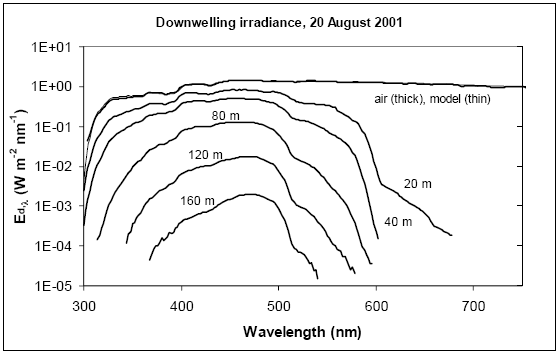Ultraviolet Radiation and Bio-optics in Crater Lake, Oregon, 2005
RESULTS
Spectral measurements of incident and underwater solar radiation
In the extremely clear water of Crater Lake the wavelengths penetrating most deeply were in the blue waveband (400–500 nm). Incident and underwater spectra recorded on 20 August 2001 (a date when the surface waters were unusually transparent) are shown on a logarithmic irradiance scale for a range of depths in Figure 1A. Incident irradiance measurements made with the LI-COR LI-1800uw scanning radiometer were validated by comparing with model data for incident irradiance under ambient conditions (also plotted); in most of the UV range (310–400 nm) the ratio of Measured:Modeled ranged from 87% to 108% and averaged 96%. Underwater the solar radiation diminished with increasing depth; both short and long wavelengths were attenuated more rapidly than those in the blue range (400–500 nm), resulting in a broad peak from 400–500 nm at 80 m and a narrower peak from 460–480 nm at 160 m. The limit of detection of the LI-COR LI-1800-uw scanning radiometer (Kirk et al., 1994) is reached between 10-4 and 10-5 Watts m-2 mn-1depending on the wavelength. For comparison with relative attenuation depths reported for other natural waters Figure 1B shows curves for both 10% and 1% attenuation depths across the UV and part of the visible spectrum derived from the data plotted in figure 1A. Figure 1A shows that underwater irradiance is attenuated fairly evenly by wavelengths from 390–490 nm (also evident in the low slope of Figure 1B for wavelengths >390 nm). The most rapid attenuation with depth was at wavelengths longer than 600 nm.
Spectral upwelling irradiance, Eu (Figure 2A, measured on the same date as Figure 1 data with a PRR-800 radiometer equipped with 18 filter wavebands (lowered in inverted orientation so that cosine irradiance sensors faced downward) suggests the quality of light that would be visible from above the surface. The peak waveband is 412 nm (violet), with a nearly constant intensity from 380–490 nm (UV-A through blue). Another peak at 683 nm (the red peak emission wavelength for chlorophyll-a fluorescence) is evident at all depths but more distinct below 30 m. Figure 2B shows the reflectance ratio of upwelling radiance (Lu) to downwelling irradiance (Ed) at different depths (PRR-800 was used in its normal orientation), with a regular spectral pattern of declining Lu:Ed at increasing wavelengths observed for shallow depths, but with increasing depth there is a dramatic rise in reflectance for longer wavelengths (>590 nm at 15 m depth, >565 nm at 25 m, and > 490 nm at 120 m).


